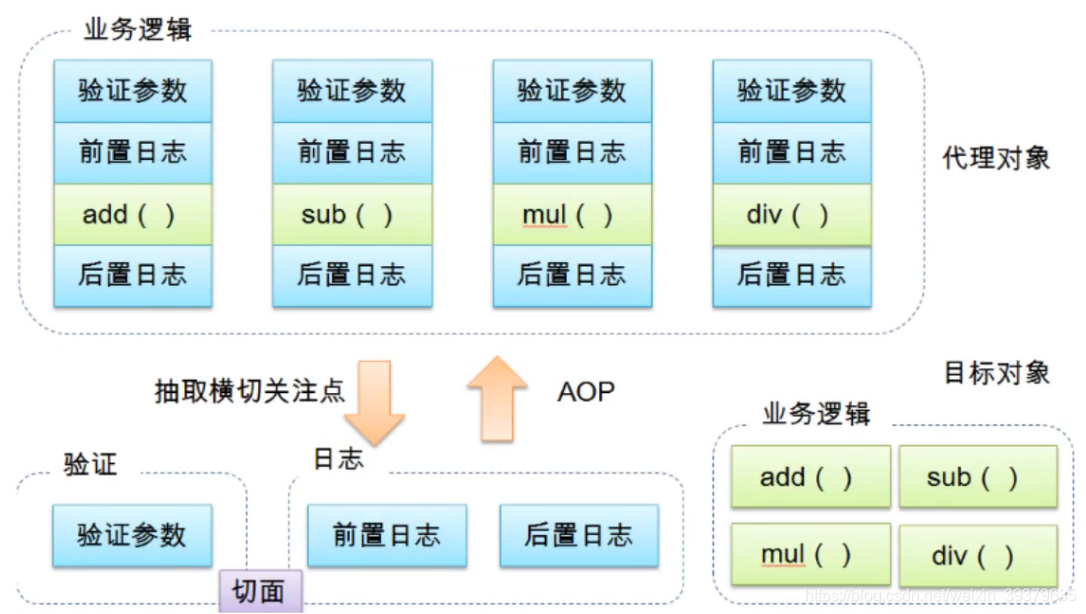Spring系列 10
10、AOP
10.1、什么是AOP?
AOP (Aspect Oriented Programming)意为:面向切面编程,通过预编译方式和运行期动态代理实现程序功能的统一维护的一种技术。AOP是OOP的延续,是软件开发中的一个热点,也是Spring框架中的一个重要内容,是函数式编程的一种衍生范型。利用AOP可以对业务逻辑的各个部分进行隔离,从而使得业务逻辑各部分之间的耦合度降低,提高程序的可重用性,同时提高了开发的效率。

10.2、AOP在Spring中的作用
== 提供声明式事务;允许用户自定义切面==
- 横切关注点:跨越应用程序多个模块的方法或功能。即是,与我们业务逻辑无关的,但是我们需要关注的部分,就是横切关注点。如日志,安全,缓存,事务等等…
- 切面(ASPECT):横切关注点被模块化的特殊对象。即,它是一个类。
- 通知(Advice) :切面必须要完成的工作。即,它是类中的一个方法。
- 目标(Target) :被通知对象。
- 代理(Proxy) :向目标对象应用通知之后创建的对象。
- 切入点(PointCut):切面通知执行的"地点"的定义。
- 连接点(JointPoint):与切入点匹配的执行点。

SpringAOP中,通过Advice定义横切逻辑,Spring中支持5种类型的Advice:
| 通知类型 | 连接点 | 实现接口 |
|---|---|---|
| 前置通知 | 方法前 | org.springframework.aop.MethodBeforeAdvice |
| 后置通知 | 方法后 | org.springframework.aop.AfterReturningAdvice |
| 环绕通知 | 方法前后 | org.aopalliance.intercept.MethodInterceptor |
| 异常抛出通知 | 方法抛出异常 | org.springframework.aop.ThrowsAdvice |
| 引介通知 | 类中增加新的方法属性 | org.springframework.aop.IntroductionInterceptor |
即AOP在不改变原有代码的情况下,去增加新的功能
10.3、使用Spring实现AOP
【重点】使用AOP,需要导入一个依赖包
<!-- https://mvnrepository.com/artifact/org.aspectj/aspectjweaver -->
<dependency>
<groupId>org.aspectj</groupId>
<artifactId>aspectjweaver</artifactId>
<version>1.9.5</version>
</dependency>
方式一:使用Spring的API接口【主要是Spring的API接口实现】
- 添加日志功能
## Log.java
public class Log implements MethodBeforeAdvice {
//method:要执行的目标对象的方法
//args:参数
//target:目标对象
public void before(Method method, Object[] args, Object target) throws Throwable {
System.out.println(target.getClass().getName()+"被执行了");
}
}
- 后置通知
## AfterLog.java
public class AfterLog implements AfterReturningAdvice {
//returnValue:返回值
public void afterReturning(Object returnValue, Method method, Object[] args, Object target) throws Throwable {
System.out.println("执行了"+method.getName() + ".返回结果为" + returnValue);
}
}
- 配置文件
##applicationContext.xml
<bean id="userService" class="com.only.service.UserServiceImpl"/>
<!-- 方式一:使用原生Spring API接口 -->
<bean id="log" class="com.only.log.Log"/>
<bean id="afterLog" class="com.only.log.AfterLog"/>
<!-- 配置AOP : 需要导入AOP的约束-->
<aop:config>
<!-- 切入点 -->
<aop:pointcut id="pointcut1" expression="execution(* com.only.service.UserServiceImpl.*(..))"/>
<!-- 执行环绕增加 -->
<aop:advisor advice-ref="log" pointcut-ref="pointcut1"/>
<aop:advisor advice-ref="afterLog" pointcut-ref="pointcut1"/>
</aop:config>
- 测试
#MyTest.java
public class MyTest {
public static void main(String[] args) {
ClassPathXmlApplicationContext context = new ClassPathXmlApplicationContext("applicationContext.xml");
//【注意】动态代理代理的是接口,应该是UserService而不是UserServiceImpl
UserService userService = context.getBean("userService", UserService.class);
userService.add();
}
}
- 测试结果

方式二:自定义实现AOP【主要是切面定义】
- 自定义切点
##DiyPointCut.java
public class DiyPointCut {
public void before(){
System.out.println("=============方法执行前==========");
}
public void after(){
System.out.println("=============方法执行后==========");
}
}
- 配置文件
##applicationContext.xml
<bean id="userService" class="com.only.service.UserServiceImpl"/>
<!-- 方式二:自定义类 -->
<bean id="diy" class="com.only.diy.DiyPointCut"/>
<aop:config>
<!-- 自定义切面,ref 要引用的类 -->
<aop:aspect ref="diy">
<!-- 切入点 -->
<aop:pointcut id="diypointcut" expression="execution(* com.only.service.UserServiceImpl.*(..))"/>
<!-- 通知 -->
<aop:before method="before" pointcut-ref="diypointcut"/>
<aop:after method="after" pointcut-ref="diypointcut"/>
</aop:aspect>
</aop:config>
- 测试(同上)
- 测试结果

方式三:使用注解实现
- 配置文件
##applicationContext.xml
<bean id="userService" class="com.only.service.UserServiceImpl"/>
<!-- 方式三:注解 -->
<bean id="annotationPointCut" class="com.only.diy.AnnotationPointCut"/>
<aop:aspectj-autoproxy/>
- 注解实现AOP
## AnnotationPointCut.java
//方式三:使用注解实现AOP
@Aspect //标注这个类为切面
public class AnnotationPointCut {
@Before("execution(* com.only.service.UserServiceImpl.*(..))")
public void before() {
System.out.println("=======方法执行前===========");
}
@After("execution(* com.only.service.UserServiceImpl.*(..))")
public void after() {
System.out.println("========方法执行后===========");
}
//在环绕增强中,我们可以给定一个参数,代表我们要获取处理切入的点
@Around("execution(* com.only.service.UserServiceImpl.*(..))")
public void around(ProceedingJoinPoint jp) throws Throwable {
System.out.println("环绕前");
//执行方法
Object proceed = jp.proceed();
System.out.println("环绕后");
}
}
- 测试同上,测试结果:
